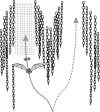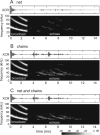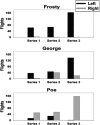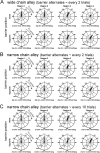Effective biosonar echo-to-clutter rejection ratio in a complex dynamic scene
- PMID: 26328724
- PMCID: PMC4552698
- DOI: 10.1121/1.4915001
Effective biosonar echo-to-clutter rejection ratio in a complex dynamic scene
Abstract
Biosonar guidance in a rapidly changing complex scene was examined by flying big brown bats (Eptesicus fuscus) through a Y-shaped maze composed of rows of strongly reflective vertical plastic chains that presented the bat with left and right corridors for passage. Corridors were 80-100 cm wide and 2-4 m long. Using the two-choice Y-shaped paradigm to compensate for left-right bias and spatial memory, a moveable, weakly reflective thin-net barrier randomly blocked the left or right corridor, interspersed with no-barrier trials. Flight path and beam aim were tracked using an array of 24 microphones surrounding the flight room. Each bat flew on a path centered in the entry corridor (base of Y) and then turned into the left or right passage, to land on the far wall or to turn abruptly, reacting to avoid a collision. Broadcasts were broadly beamed in the direction of flight, smoothly leading into an upcoming turn. Duration of broadcasts decreased slowly from 3 to 2 ms during flights to track the chains' progressively closer ranges. Broadcast features and flight velocity changed abruptly about 1 m from the barrier, indicating that echoes from the net were perceived even though they were 18-35 dB weaker than overlapping echoes from surrounding chains.
Figures









References
-
- Gillette, M. D. , and Silverman, H. F. (2008). “ A linear closed-form algorithm for source localization from time-differences of arrival,” IEEE Signal Process. Lett. 15, 1–4.10.1109/LSP.2007.910324 - DOI
Publication types
MeSH terms
Grants and funding
LinkOut - more resources
Full Text Sources
Other Literature Sources
Miscellaneous

